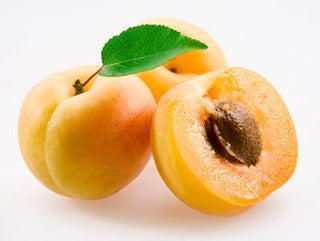(Prunus armeniaca)
Also known as the “Armenium plum”, the deeply colored orange apricot is one of the first signs of summer. Similar to peaches, apricots are covered in a velvety skin. And, like plums, apricots are very sweet and tangy in taste.
History
Originally from China, apricots have been cultivated for over 4,000 years. From China, the apricot traveled through the Mediterranean and the Asian regions of Himalaya and Armenia. The apricot was later introduced to the United States by Spanish Explorers, where they cultivated the fruit in the missions all over California.
Today, 95 percent of all apricot cultivation is in Central California. Many different varieties grow in California, each with special characteristics, but the most prevalent varieties include the Pattersons, Blenheims, Tiltons and Castlebrites.
Nutrition Data
Like all fruits, apricots have a high carbohydrate content, most of which is sugars. One cup of raw apricots contains 74 calories, 17 grams of carbohydrates of which 3 grams are from fiber. Compared with fresh, dried apricots have a higher fiber content, but also have a significantly higher sugar content (one cup dried has 313 calories, 81 gram of carbohydrates, 9 grams of fiber and 69 gram of sugars).
Apricots are a very good source of vitamin A (2,985 IUs) and vitamin C (16 mg) and a good source of potassium (401 mg). Dried apricots are a more concentrated source of vitamin A, providing almost 5,000 IUs per cup. Of any food, apricots possess the highest levels and widest variety of carotenoids (beta carotene, beta cryptoxanthin, lutein, zeaxanthin, alpha carotene). These carotenoids not only give this fruit its distinctive orange color, but act as antioxidants, their levels which increase as the fruit ripens.
Selection & Storage
Apricots are available year-round if dried or canned; however, fresh apricots are in season from May until August. The fruit ranges in color from yellow to deep orange.
When selecting fresh apricots, be sure to pick fruit that is fully ripened. Avoid apricots that are yellow and firm. Ripe apricots are a rich orange color. The best fruit will be soft; this is a sign that the apricot has been ripened while on the tree. If you’re fortunate to live in California, you can purchase fresh, organically grown apricots by locating a California Certified Farmers Market near you.
Fresh apricots must be eaten immediately. Apricots that aren’t fully ripened will ripen at room temperature. Once an apricot has hit its peak, place the fruit in a bag and store it in the refrigerator where it will stay fresh for 2 days. Thoroughly wash the fruit prior to eating.
Dried apricots that appear orange have been treated with sulfites to preserve color and extend shelf-life. Sulfites can cause problems for a number of individuals. Organic dried apricots, with their brownish appearance, don’t look as appetizing but don’t cause the gastrointestinal associated with sulfites.
Apricot kernels are used for several culinary purposes due to their strong and bitter taste. The most famous uses are in Italian amaretto cookies and the liqueur Amaretto di Saronno. The kernels are also used to give a strong after-taste to apricot jams.
Recipes
Apricots can be eaten several different ways but eating them raw is the most popular way of enjoying this delicious fruit.
This Apricot & Strawberry Salad is a simple, delicious way to enjoy both summer fruits for breakfast or dessert. The New York Times offers other healthy recipes featuring apricots.
Dried apricots are a great, tasty snack on the go. Or, try this Fruited Rice Pilaf which uses dried apricots to liven up an ordinary rice dish.
Fun Facts
In Latin, apricot translates to “precious.” The apricot was given this name because it ripened before any other summer fruit.
Laetrile, a purported alternative treatment for cancer, is extracted from apricot seeds which have a high cyanide content. Apricot kernels contain about 0.5mg of cyanide each and such can be a cause of cyanide poisoning if taken in excessive quantities.

